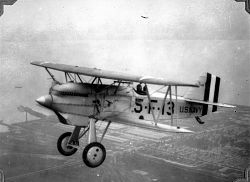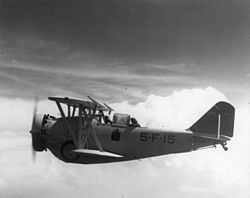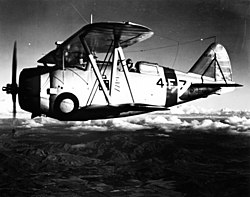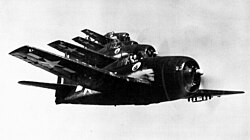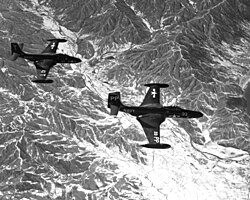
Strike Fighter Squadron 103 (VFA-103), nicknamed the Jolly Rogers, is an aviation unit of the United States Navy established in 1952. VFA-103 flies the F/A-18F Super Hornet and is based at Naval Air Station Oceana, Virginia (US). The squadron's radio callsign is Victory and it is assigned to Carrier Air Wing Seven.

Strike Fighter Squadron 11 (VFA-11) is a United States Navy strike fighter squadron stationed at Naval Air Station Oceana, Virginia, United States. The squadron was established in 1950 and is nicknamed "Red Rippers". VFA-11 is equipped with the Boeing F/A-18F Super Hornet and currently assigned to Carrier Air Wing One.

Fighter Squadron 111 (VF-111), also known as the Sundowners, was a fighter squadron of the United States Navy. Originally established as Fighter Squadron 11 (VF-11) on 10 October 1942, it was redesignated as VF-11A on 15 November 1946, redesignated as VF-111 on 15 July 1948 and disestablished on 19 January 1959. On 20 January, another squadron, VF-111 (1956-95) then assumed the designation until its de-establishment in 1995. In November 2006, VFC-13 Detachment Key West was redesignated as VFC-111, taking on the Sundowner insignia and callsign.

Fighter Squadron 194 (VF-194) was an aviation unit of the United States Navy. It was originally established as VF-91 on 26 March 1952, redesignated VF-194 on 1 August 1963 and disestablished on 1 March 1978. It was the third US Navy squadron to be designated VF-194.

Fighter Squadron 53, or VF-53Iron Angels was an aviation unit of the United States Navy in service from 20 July 1950 to 29 January 1971. Originally established as reserve squadron VF-721 on 20 July 1950, it was redesignated as VF-141 on 4 February 1953 and then redesignated as VF-53 on 15 October 1963. The squadron was disestablished on 29 January 1971. It was the fourth US Navy squadron to be designated as VF-53.

Strike Fighter Squadron 81 (VFA-81), also known as the "Sunliners", is a United States Navy F/A-18E Super Hornet strike fighter squadron stationed at Naval Air Station Oceana. They are a part of Carrier Air Wing One, their radio callsign is Inferno, and their tail code is AB. Their mission is to conduct prompt and sustained combat operations from the sea. The squadron was originally designated VA-66 on 1 July 1955, was redesignated VF-81 the same day, redesignated VA-81 on 1 July 1959, and finally redesignated VFA-81 on 4 February 1988.

Attack Squadron TWELVE, also known as the "Flying Ubangis" or "Clinchers", was an attack squadron of the United States Navy active during the Cold War. From their home port at Naval Air Station Cecil Field in Florida, the squadron made more than thirty major overseas deployments aboard aircraft carriers, primarily flying A-4 Skyhawk and later the A-7E Corsair II, including two combat tours in the Vietnam War.

Carrier Air Wing Thirteen (CVW-13) was a carrier air wing of the United States Navy established for a short period at the end of the Cold War. There were three previous units which had been named Carrier Air Group Thirteen (CVG-13), dating as far back as 1942, though each of these units has a distinct lineage.

Fighter Squadron 96, or VF-96Fighting Falcons was an aviation unit of the United States Navy in service from 1962 to 1975. When assigned to Carrier Air Wing Nine (CVW-9) their tailcode was NG, and their radio callsign was Showtime. Originally established as United States Naval Reserve squadron VF-791Fighting Falcons on 20 July 1950 it was redesignated VF-142 after becoming a regular squadron on 4 February 1953. It was re-designated VF-96 on 1 June 1962 and disestablished on 1 December 1975.
VF-43 was a Fighter Squadron of the U.S. Navy. The squadron was originally established as Fighter Squadron 74A (VF-74A) on 1 May 1945, it was redesignated Fighter Squadron 74 (VF-74) on 1 August 1945, redesignated VF-1B on 15 November 1946, redesignated VF-21 on 1 September 1948, redesignated as Attack Squadron 43 (VA-43)Challengers on 1 July 1959 and Fighter Squadron 43 (VF-43) on 1 June 1973. It was disestablished on 1 July 1994.

Fighter Squadron 52 or VF-52 was an aviation unit of the United States Navy. Originally established as Bombing Fighting Squadron 5 (VBF-5) on 8 May 1945, it was redesignated Fighting Squadron 6A (VF-6A) on 15 November 1946, redesignated as Fighter Squadron 52 (VF-52) on 16 August 1948 it was disestablished on 23 February 1959. It was the third US Navy squadron to be designated as VF-52.
Fighter Squadron 171 or VF-171 was an aviation unit of the United States Navy. Originally established as Fighter Squadron 82 (VF-82) on 1 April 1944, it was redesignated VF-17A on 15 November 1946, redesignated as VF-171 on 11 August 1948 and disestablished on 15 March 1958.

Fighter Squadron 22 or VF-22 was an aviation unit of the United States Navy. Originally established as Bombing Fighting Squadron 74A (VBF-74A) on 1 May 1945, it was redesignated VBF-74 on 1 August 1945, redesignated as VF-2B on 15 November 1946, redesignated as VF-22 on 1 September 1948, it was disestablished on 6 June 1958.

Fighter Squadron 124 or VF-124 was an aviation unit of the United States Navy. Originally established as Reserve Squadron VF-874 it was called to active duty on 20 July 1950, redesignated VF-124 on 4 February 1953, it was disestablished on 10 April 1958.
Fighter Squadron 2 or VF-2 was an aviation unit of the United States Navy. Established on 1 June 1943, it was disestablished on 9 November 1945. It was the third US Navy squadron to be designated as VF-2.
Fighting Squadron 8 or VF-8 was an aviation unit of the U.S. Navy. It was originally established 2 September 1941 and disestablished on 28 August 1942.
Fighting Squadron 72 or VF-72 was an aviation unit of the U.S. Navy, originally established as VF-7 on 1 July 1939, it was redesignated as VF-72 on 19 November 1940 and disestablished on 29 March 1943.
Fighter Squadron 7 or VF-7 was an aviation unit of the U.S. Navy, originally established on 3 January 1944, it was disestablished on 8 June 1946. It was the second US Navy squadron to be designated VF-7.
Fighting Squadron 9 or VF-9 was an aviation unit of the U.S. Navy, originally established on 1 March 1942, it was disestablished on 28 September 1945.
Carrier Air Group Seventeen (CVG-17) was a designation used by the United States Navy to identify two unrelated Carrier Air Groups; the first of which was established on 1 January 1943 as Carrier Air Group Seventeen and disestablished on 1 April 1992 as Carrier Air Wing Six; and the second of which was established as Carrier Air Group Eighty Two on 1 April 1944 and ultimately disestablished as Carrier Air Group Seventeen on 16 September 1968. Neither group shares a lineage with the current Carrier Air Wing Seventeen (CVW-17) as the first was the forerunner of CVW-6 and the second was disestablished eight years before CVW-17 was established.
